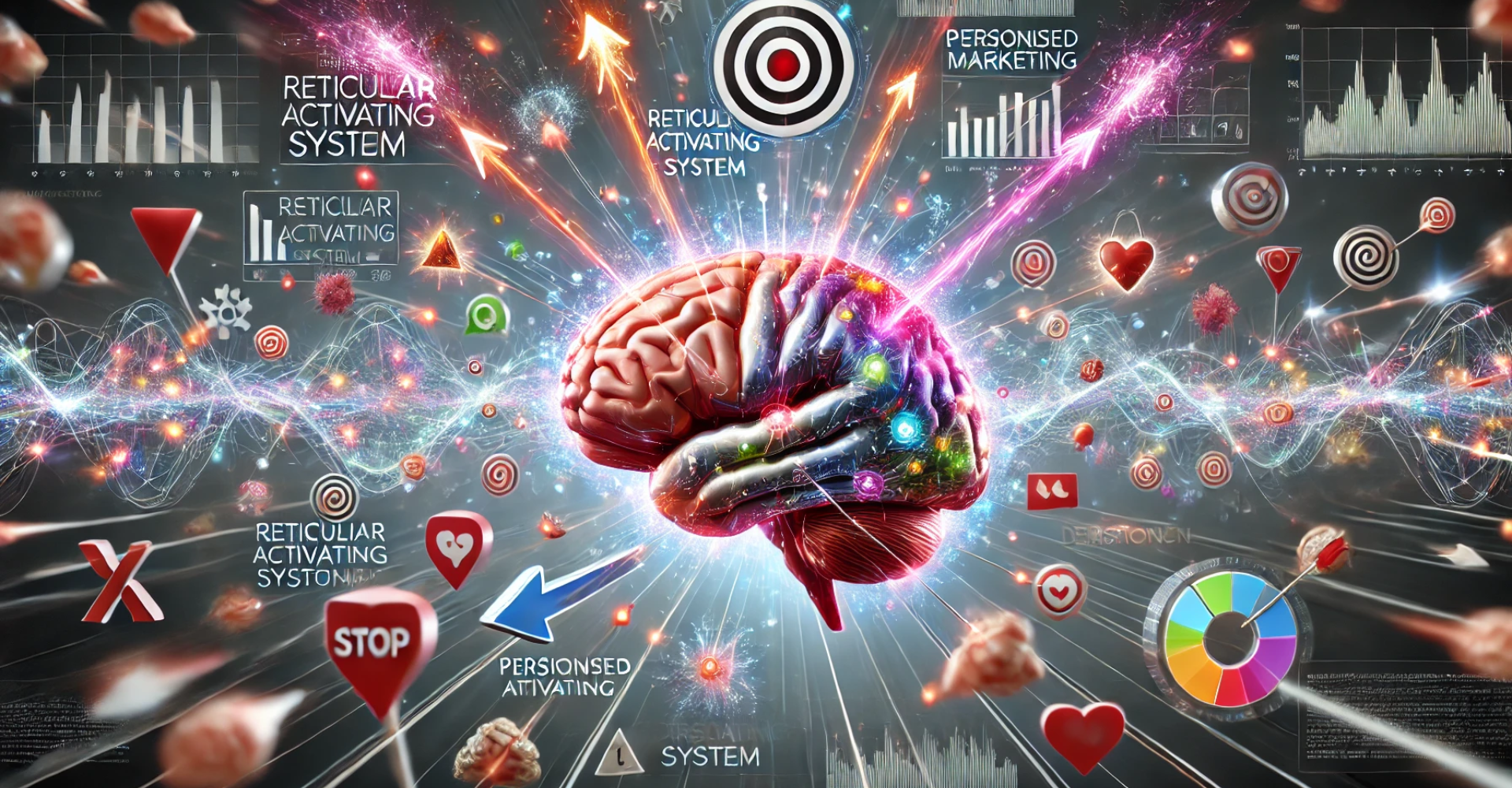Tricking the Brain: How to Use the Reticular Activating System (RAS) to Capture Your Audience’s Attention
How the Reticular Activating System (RAS) Can Boost Your Marketing Strategy

In the fast-paced world of marketing, grabbing—and holding—your audience’s attention is key. But how do you cut through the noise and make sure your message sticks? The answer might lie in how the brain itself works, specifically the Reticular Activating System (RAS).
The RAS is a network of neurons in the brainstem that acts like a filter, determining what sensory information reaches our conscious awareness. Think of it as your brain’s gatekeeper, deciding what’s worth paying attention to and what can be ignored. Marketers can take advantage of this system to create campaigns that align with how people naturally process information, making sure their messages rise above the competition.
A Real-Life Example of the RAS in Action
To understand how the RAS works in everyday life, imagine being at a crowded party. There’s music playing, people talking, and a lot of background noise. Yet, if someone across the room says your name, you immediately notice it. That’s your RAS at work. Even in a sea of distractions, your brain is alert to information that’s personally important to you—like your name.
Marketers can use the same principle. When their message aligns with something their audience values or is actively thinking about, it stands out from the background noise, much like hearing your name at a party.
Six Ways to Leverage the RAS in Marketing
Here are six ways marketing companies can use the RAS to craft campaigns that capture attention and resonate deeply with their audience:
1. Targeted Messaging
Since the RAS filters information based on what individuals find important, personalized and targeted messaging is essential. By tailoring your content to resonate with your audience’s values, beliefs, and pain points, you increase the chances of your message breaking through the noise. Using specific language and imagery that aligns with their mindset makes your marketing more relatable and noticeable.
2. Tap Into Emotional Triggers
The RAS responds strongly to emotional stimuli. If your marketing can evoke strong emotions—such as joy, excitement, or even urgency—you’re more likely to capture attention. Emotional storytelling, for example, forms deeper connections with your audience, helping your message stick. Brands that tap into universal emotions, like family or success, often create long-lasting bonds with their audience.
3. Consistency Is Key
To make sure your brand stays top of mind, consistent branding is crucial. The more frequently people are exposed to the same logos, taglines, or color schemes, the easier it becomes for their RAS to recognize and prioritize your brand. Consistency across all marketing channels—whether in social media posts, ads, or emails—helps your audience quickly identify your brand, which builds trust and familiarity.
4. Create Urgency and Scarcity
The RAS is also attuned to novelty and urgency. By incorporating time-sensitive offers or exclusive deals, you trigger a sense of urgency in potential customers. People are more inclined to act when they feel they might miss out on something valuable. Highlighting limited-time promotions or exclusive opportunities helps engage the audience and pushes them to take action before the chance slips away.
5. Focus on Personal Goals
People are more likely to notice information that aligns with their personal goals or aspirations. Craft marketing messages that show how your product or service can help your audience achieve these goals. If your offering directly addresses their needs, the RAS is more likely to prioritize your message. For example, fitness brands that highlight specific health milestones or transformations capture the attention of customers who have set personal fitness goals.
6. Leverage Social Proof and Authority
The RAS is sensitive to social cues and the opinions of trusted individuals. Using social proof through testimonials, reviews, or influencer marketing can help your message stand out. When people see others endorsing your product—especially individuals they admire or relate to—it triggers the RAS, making your brand more noticeable and credible. Building trust through social proof is a powerful way to elevate your marketing.
How Can You Change Your RAS – And How Can Marketers Help?
The RAS isn’t a static filter—it can be retrained to focus on different things, depending on what we consciously choose to prioritize. Just as people can “train” their RAS to pick up on new goals or interests, marketers can guide this process by aligning their messaging with their audience's evolving needs.
How People Can Change Their RAS
- Setting New Goals: When someone sets clear goals, their brain becomes more attuned to opportunities and information that help achieve those objectives. For example, if someone decides they want to buy a new car, they start noticing car ads, deals, or specific models that they didn’t notice before. Their RAS is now trained to prioritize car-related information because it aligns with their current goal.
- Positive Reinforcement: Consciously focusing on positive experiences and affirmations can train the RAS to notice more positive opportunities. Practices like gratitude journaling or vision boards help individuals condition their brain to filter for positive outcomes that align with their desired future.
How Marketers Can Influence the RAS
Marketers can guide the way people change their RAS by helping their audience focus on specific aspirations and making sure the brand is part of that process. Here’s how:
- Creating Compelling Goals: Help your audience set new goals by positioning your product as the key to achieving something they desire. If your product can be linked to a clear goal—like health, success, or happiness—your audience’s RAS will naturally become more attuned to your brand. For instance, a financial services company can present its offerings as the foundation for future financial security, helping customers set and focus on financial goals.
- Repetition and Consistency: The RAS is influenced by repetition. When your message is consistently delivered across various platforms, it reinforces the idea in the audience’s mind. Over time, their RAS will be more likely to pick up on your brand because it has been exposed to it frequently in a consistent, recognizable way.
- Using Emotional or Sensory Cues: Engaging the senses with vibrant visuals, compelling videos, or emotional storytelling helps trigger the RAS. When marketing campaigns use sensory-driven elements or evoke strong emotions, they are more likely to be noticed. For example, creating a visually striking ad or an emotionally resonant video can ensure your message stands out from competitors.
- Highlighting Transformation: Show the transformation your product or service can bring into a person’s life. When people see real-life examples or aspirational stories, they start to connect your offering with their own goals. This connection helps train their RAS to notice your brand when similar situations arise in their daily lives.
Wrapping It Up
In today’s crowded marketplace, understanding how the brain processes information can give marketers a major advantage. By tapping into the Reticular Activating System, your marketing company can craft campaigns that not only grab attention but also resonate deeply with your audience. From creating emotional connections to aligning your message with personal goals, understanding and leveraging the RAS ensures that your message rises above the noise and leaves a lasting impact.
Disclaimer: Portions of this content were generated with the assistance of AI technology. While AI helped craft some parts of this post, the final version was reviewed and edited by Travis Hall to ensure accuracy and relevancy.












